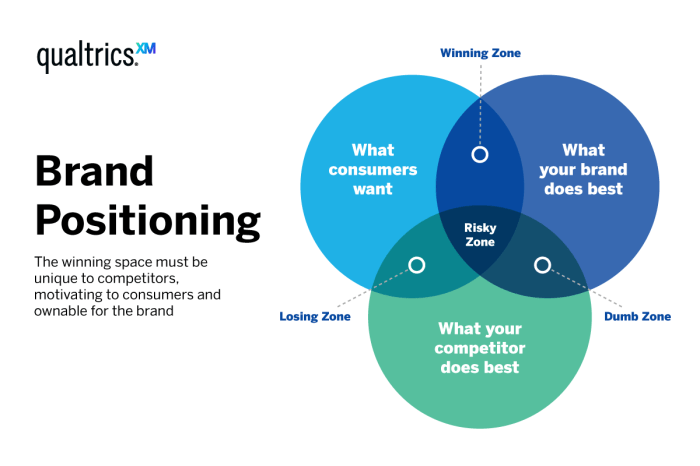Brand Positioning Strategies set the stage for success in the cutthroat world of marketing, where every move counts towards establishing a distinct identity and attracting the right audience. Dive into the realm of strategic brand positioning and discover how top players in the industry stay ahead of the game.
From defining brand positioning to executing a winning strategy, this guide unveils the intricate process behind creating a compelling brand presence that resonates with consumers.
Overview of Brand Positioning Strategies

Brand positioning strategies in marketing refer to the efforts a company makes to create a distinct image and identity for its products or services in the minds of consumers. It involves defining how a brand is different from its competitors and how it fulfills the needs and desires of its target audience.
Examples of Successful Brand Positioning Strategies
- Apple: Apple has positioned itself as a premium and innovative technology brand, focusing on sleek design and user-friendly interfaces. This strategy has helped Apple build a loyal customer base willing to pay a premium for its products.
- Nike: Nike has positioned itself as a brand for athletes and sports enthusiasts, emphasizing performance and motivation. Through powerful branding and endorsements from top athletes, Nike has established itself as a leader in the sports apparel industry.
- Coca-Cola: Coca-Cola has positioned itself as a timeless and iconic brand that brings people together through shared experiences and happiness. This emotional connection has helped Coca-Cola maintain its status as one of the most recognizable brands in the world.
The Importance of Having a Strong Brand Positioning Strategy
A strong brand positioning strategy is crucial in today’s competitive market to differentiate a brand from competitors, create a unique identity, and build customer loyalty. It helps consumers understand the value proposition of a brand and why they should choose it over other options. A well-defined brand positioning strategy can also guide marketing efforts, product development, and customer communication, ultimately leading to increased sales and long-term success.
Types of Brand Positioning Strategies
Brand positioning strategies are crucial for companies to differentiate themselves in the market and create a strong brand image. Let’s take a look at different types of brand positioning strategies and their advantages and disadvantages.
Value-based Brand Positioning, Brand Positioning Strategies
Value-based brand positioning focuses on the value proposition that a brand offers to its customers. Companies using this strategy emphasize the benefits and value that their products or services provide to consumers.
Advantages:
– Helps create a strong emotional connection with customers.
– Allows companies to charge premium prices for their products or services.
Disadvantages:
– Can be challenging to maintain a consistent value proposition.
– Requires continuous innovation to deliver on the promised value.
Examples:
– Apple positions itself as a brand that offers innovative and user-friendly technology products, focusing on the value of simplicity and design.
Quality-based Brand Positioning
Quality-based brand positioning emphasizes the superior quality of a brand’s products or services compared to competitors. Companies using this strategy focus on delivering high-quality products to meet the needs and expectations of their target market.
Advantages:
– Builds trust and credibility with customers.
– Helps create a loyal customer base.
Disadvantages:
– Requires significant investment in research and development.
– Competition in the quality segment can be intense.
Examples:
– Mercedes-Benz positions itself as a brand that offers luxury vehicles with superior engineering and quality, targeting customers who value performance and craftsmanship.
Competitor-based Brand Positioning
Competitor-based brand positioning involves positioning a brand in relation to its competitors in the market. Companies using this strategy differentiate themselves by highlighting their unique selling points and advantages over competitors.
Advantages:
– Helps companies identify gaps in the market.
– Allows companies to capitalize on competitor weaknesses.
Disadvantages:
– Can lead to a reactive approach rather than proactive innovation.
– Difficult to sustain a unique positioning if competitors quickly imitate.
Examples:
– Pepsi positions itself as a fun and youthful alternative to Coca-Cola, focusing on a different brand image and target audience compared to its main competitor.
Developing a Brand Positioning Strategy

When developing a brand positioning strategy, there are several key steps that need to be followed in order to effectively differentiate your brand in the market.
Identifying Target Market Segments and Competitors
Before creating a brand positioning strategy, it is crucial to conduct thorough research to identify the target market segments and competitors. This involves analyzing demographic data, psychographic information, and behavioral patterns of potential customers to understand their needs and preferences. Additionally, studying competitors’ strategies, strengths, and weaknesses can help in positioning your brand uniquely.
Creating a Unique Selling Proposition (USP)
One of the most important aspects of developing a brand positioning strategy is creating a unique selling proposition (USP). A USP is a statement that clearly communicates the unique benefits and value that your brand offers to customers. This can be based on product features, quality, price, customer service, or any other factor that sets your brand apart from competitors. A strong USP helps in establishing a strong brand identity and attracting target customers.
Communicating Brand Positioning
Consistent brand messaging is crucial in brand positioning as it helps build brand recognition, trust, and loyalty among consumers. When a brand effectively communicates its unique value proposition and key messages across all touchpoints, it reinforces its position in the minds of the target audience.
Role of Advertising, Social Media, and Other Marketing Channels
Advertising, social media, and other marketing channels play a vital role in communicating brand positioning by reaching a wider audience and creating brand awareness. Through advertising campaigns, social media platforms, and other marketing initiatives, brands can showcase their values, benefits, and personality to connect with consumers on an emotional level.
- Advertising: Brands use various forms of advertising such as TV commercials, print ads, and online ads to communicate their brand positioning to a mass audience. For example, Nike’s “Just Do It” campaign reinforces its position as a brand that empowers and inspires athletes.
- Social Media: Brands leverage social media platforms like Instagram, Facebook, and Twitter to engage with consumers, share content, and reinforce brand positioning. For instance, Starbucks uses Instagram to showcase its coffee culture and community-focused values.
- Other Marketing Channels: Brands also utilize other marketing channels such as email marketing, influencer partnerships, and events to communicate their brand positioning effectively. For example, Apple’s product launches and events emphasize its innovation and design leadership.












